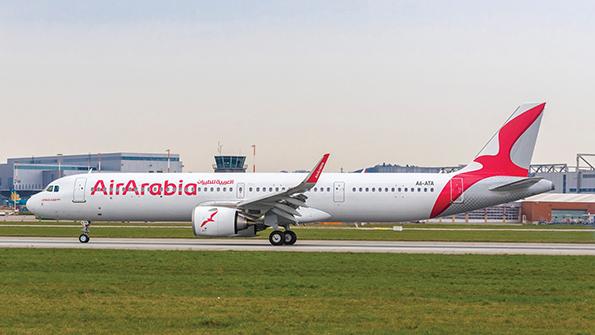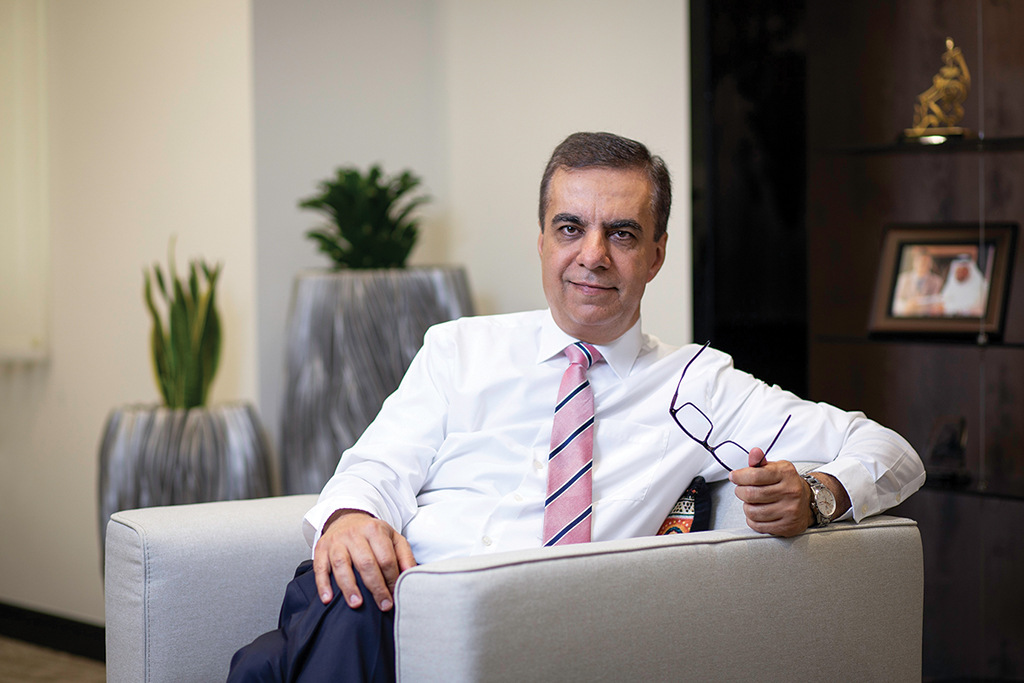
Air Arabia’s current small fleet of Airbus A321neoLRs will be joined by more examples of the type when deliveries from the airline’s large order for A320neo-family aircraft begin in 2025.
Gulf-based LCC Air Arabia has created a template for developing operating companies around the Middle East. As the longest-established LCC in the Middle East and North Africa (MENA) region, the airline has steadily expanded operations from its base in Sharjah, one of the seven constituent emirates of the UAE, through the creation of a series of JVs throughout the region.
It’s a pattern that seems to work. Since its launch in 2003, with the exception of the pandemic period, the group has been consistently profitable, with 2022 delivering record net earnings of AED 1.2 billion ($326 million). How has the JV model worked so successfully?
Air Arabia knows how to operate an airline, but understanding the local tax system and regulations, not to mention the culture of the country, is obviously better handled by local personnel, rather than executives trying to do so by remote control.
“We’ve always found that having JVs and having partnerships gives us access to the market much quicker,” group CEO Adel Ali said.
Air Arabia Maroc started life in 2009 after the Sharjah LCC linked up with local carrier Regional Air Lines.

“It was a domestic airline, operating Canadair Regional Jets on purely domestic routes and they wanted to expand the business. So, we put our arms together under a new brand,” Ali told ATW.
An added benefit of the link-up was that Morocco had, three years earlier, signed an Open Skies agreement with the European Union. The new LCC automatically gained access to what has become a swathe of routes in western Europe.
Today, Air Arabia also has an operation in Egypt (based in Alexandria, rather than Cairo), operates from two other UAE emirates (Abu Dhabi and Ras Al Khaimah), and has helped set up new operators in Armenia (FlyArna) and Pakistan (Fly Jinnah).
Moves were afoot to create another operation in Sudan before the recent bout of instability caused by two warring military groups paused developments.
The northeast African country had been under sanctions for allegedly aiding terrorist groups for some 40 years. Those measures had eased in recent years and “the world is starting to talk to them again,” Ali said.
Air Arabia linked up with Sudanese conglomerate DAL Group, which believes the underserved country can attract inbound tourists to its little-known historical sites, while providing new, overseas employment opportunities for Sudanese citizens.
“The view from the Sudanese partner is that it will be a good business to run. Obviously, with what happened a few months ago, it’s shelved until further notice,” Ali said.
The circumstances in Armenia and Pakistan are rather different from those in Morocco and Egypt. Armenia has been without a national airline since 2013 when former flag carrier Armavia collapsed, while Pakistan has a small collection of airlines serving its population of 220 million and has been rocked in recent years by allegations that many of its supposedly accredited pilots may have been flying without the appropriate qualifications and licenses.
In both countries, Air Arabia hopes that the standards by which it operates will provide a regulatory underpinning and bring consumer confidence to the new airlines in which it is involved.
“We want to make sure, from an operational point of view, that the standards we apply—IOSA and the ICAO standards that we use in the UAE—are replicated everywhere,” he said.
The regulators of the countries in which it is operating seem impressed, he said, and in some cases have adopted Air Arabia’s standards as their own.
In Armenia, Air Arabia was approached by the small Caucasus nation’s sovereign wealth fund, ANIF. Fly Arna is different from Air Arabia’s sister companies in Morocco, Egypt and Abu Dhabi. “It’s a different brand, a different culture, different regulations. This is where the local partner helps a lot,” Ali said.
At present, only two Airbus A320s have been committed to operating out of Yerevan, Armenia’s capital.
“The reason is that, when we started, there was no Ukraine-Russia conflict, which brings another dimension into this, so we’re not rapidly expanding that hub, to see what will happen,” Ali said.
The situation in Pakistan with Fly Jinnah—a JV with Pakistan’s Lakson Group, a conglomerate with financial products, insurance and consumer goods—is different again. Pakistani law requires that a new airline must start operations by flying purely domestic routes, with a minimum of three aircraft.
Flights began in October 2022 with A320s and Ali hopes that, by the end of this year, Fly Jinnah will receive permission to increase its fleet to five aircraft and be allowed to fly internationally. So far, “it’s been extremely well received by the community, with very high load factors,” he said.
Pakistan is potentially a lucrative market, with its huge population and a large diaspora, particularly in the Gulf, where thousands go to work.
ETIHAD PARTNERSHIP
Meanwhile, a short distance along the Gulf coast from its Sharjah base, Air Arabia Abu Dhabi is a JV with Etihad Airways and is one of a growing number of LCCs providing services for the region’s seemingly never-ending passenger growth.
“Etihad invited us. They weren’t covering a lot of places and we were invited to see if we could help them with low-cost, point-to-point business that they weren’t getting. They wanted some feed from quite a lot of countries they weren’t operating to,” Ali said.
Etihad holds a 51% majority stake in the enterprise.
Despite beginning operations in the middle of the pandemic and the added competition of major European LCC Wizz Air setting up a similar operation in Abu Dhabi at around the same time, the company’s operation is expanding steadily, with 12 aircraft now operating out of the UAE’s federal capital.
Prospects again seem good. Etihad, after a period of retrenchment, seems ready to start expanding once more under new CEO Antonoaldo Neves. Additionally, Abu Dhabi is steadily increasing its tourism offerings and Abu Dhabi International Airport is expected to open its vast, much-delayed Midfield Terminal on Dec. 2. All these factors “are attracting quite a lot of business into the place,” Ali noted.
The one nation in which Air Arabia’s growth has been stymied is Jordan.
In 2015, after having tried to start operations in Jordan for some years, the airline took a 49% stake in Jordanian carrier Petra Airlines and planned to open a new hub at Amman’s Queen Alia International Airport.
By 2017, however, it had largely limited its operations from Amman hub to charter flights, after being unable to secure sufficient traffic rights to allow it to expand its scheduled services. Two years later, Air Arabia closed down its Amman operation. At the time, Ali said that it was just not viable.
Ali acknowledges he would dearly like to set up his own, fully owned operations in countries around the region, but is barred from doing so.
“I’d have loved to, but the regulations don’t allow me to do so,” he said.
Whereas in the European Union, one EU-based airline can set up a sister company anywhere else in the 27-nation bloc, that’s not an option available to Air Arabia.
“In the countries where we operate, to get an AOC [the regulators] require a minimum of 51% of [local] ownership. Each company is a local entity within the country and they have their own board,” Ali said. “Because of that, we do a JV where we become the minority shareholder and manage the carrier in terms of day-to-day operations. The board manages the strategic decisions.”
This template does, however, bring benefits, as the local partner brings an understanding of its market that would be difficult for Air Arabia to achieve. For example, the carrier has had an operation in Morocco for 13 years. The distance from Sharjah to Casablanca is 7,570 km (4,100 nm), or roughly nine hours’ flying time from the UAE.
FLEET GROWTH
Air Arabia operates a fleet of 62 Airbus A320s, plus nine A321neoLRs, which are used for longer sectors of up to seven hours, to destinations such as Milan and Kuala Lumpur.
“We have one of the highest utilizations in the world and everything we have is busy,” Ali said. That means leasing in extra capacity for some of the JVs.
A combination of well-known supply chain challenges—Ali told ATW at the IATA AGM in Istanbul in June that an engine shop visit had increased from 60 to 90 days and could take as long as 180—and the Pratt & Whitney GTF engine problems affecting new-generation A320s meant that the LCC leased 10 aircraft in 2022 and the same number this year. More will be required for 2024.
“We’ve already signed for seven,” Ali said in September “and are looking for more. But we’re looking for A320ceos, not neos.”
2025 will start to see infusions from an order for 120 new aircraft from Airbus. These were initially scheduled to start arriving in 2024 and will consist of a mixture of A320neos and A321neos, plus the longer-range A321neoXLR. The last of these will enable the company to stretch its network to destinations in Southeast Asia and Europe.
Ali also said that Airbus is scheduled to deliver 20 aircraft a year from 2025. While some of those will replace existing aircraft, the aim is to have a fleet of just under 200 aircraft by 2030.
Air Arabia’s pattern of building JVs seems to attract more business. “Normally, people approach us. We evaluate and look at whether they are the right partner. If all the boxes are ticked, we start the process,” he said.
The market is growing in the areas where Air Arabia and its partners have put down roots, as well as at the company’s home hub of Sharjah.
“It’s good to let the business organically grow, but if an opportunity comes up and we feel it’s the right one, of course we’ll look at it,” Ali said.”





